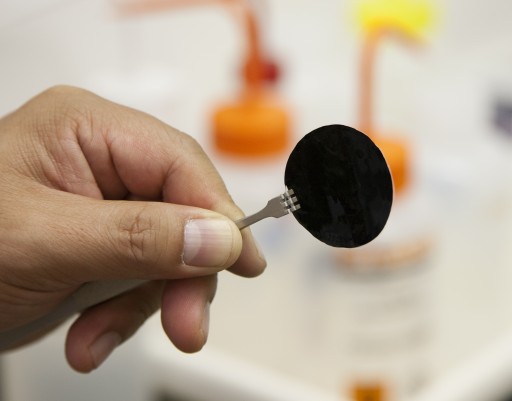New military apparel repels chemical and biological agents
October 19, 2012

The highly breathable membranes have pores made of a few nanometer-wide vertically aligned carbon nanotubes. Their surfaces are modified with a functional layer that is responsive to chemical and biological warfare agents (credit: Lawrence Livermore National Laboratory)
Lawrence Livermore National Laboratory scientists and collaborators are developing a new military uniform material that repels chemical and biological agents, using a novel carbon-nanotube (CNT) fabric.
The material will be designed to undergo a rapid transition from a breathable state to a protective state. The highly breathable membranes would have pores made of a few-nanometer-wide vertically aligned carbon nanotubes with a layer that is responsive to chemical-warfare agents.
Smart second skin
A threat would trigger a response automatically by chemical effects on the membrane surface, causing the switch to a protective state by closing the CNT pore entrance or by shedding the contaminated surface layer.
“The uniform will be like a smart second skin that responds to the environment,” said Francesco Fornasiero, LLNL’s principal investigator for the Defense Threat Reduction Agency (DTRA)-funded project.
“Without the need of an external control system, the fabric will be able to switch reversibly from a highly breathable state to a protective one in response to the presence of the environmental threat. In the protective state, the uniform will block the chemical threat while maintaining a good breathability level.”
High breathability is a critical requirement for protective clothing to prevent heat-stress and exhaustion when military personnel are engaged in missions in contaminated environments. Current protective military uniforms are based on heavyweight full-barrier protection or permeable adsorptive protective overgarments that cannot meet the critical demand of simultaneous high comfort and protection, and provide a passive rather than active response to an environmental threat.
To provide high breathability, the new composite material will take advantage of the unique transport properties of carbon nanotube pores, which have gas transport rates that are hundreds of times faster, compared to any other pore of similar size.
Biological agents, such as bacteria or viruses, are close to 10 nanometers in size. Because the membrane pores on the uniform are only a few nanometers wide, these membranes will easily block biological agents.
Surface peels off to block chemical agents
However, chemical agents are much smaller in size and require the membrane pores to be able to react to block the threat. To create a multifunctional membrane, the team will modify surfaces on the CNT membranes. Functional groups on the membrane will sense and block the threat.
A second response scheme also will be developed. Similar to how a living skin peels off when challenged with dangerous external factors, the fabric will exfoliate upon reaction with the chemical agent. In this way, the fabric will be able to block chemical agents such as sulfur mustard (blister agent), GD and VX nerve agents, toxins such as staphylococcal enterotoxin and biological spores such as anthrax.
“This futuristic uniform would allow our military forces to operate safely for extended time periods and successfully complete their missions in environments contaminated with chemical and biological warfare agents,” said Tracee Harris, the DTRA science and technology manager for the Dynamic Multifunctional Material for a Second Skin Program.
The project is funded for $13 million over five years with LLNL as the lead institution. The new uniforms could be deployed in the field in less than 10 years.
The Laboratory has a history in developing carbon nanotubes for a wide range of applications, including desalination.